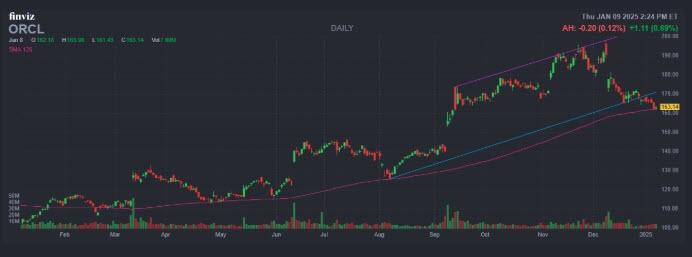Oracle (ORCL), a prominent player in the cloud computing and artificial intelligence arena, has experienced a significant price correction despite boasting a substantial year-over-year growth of 57.4%. The stock, which reached a record high of $198.30 on December 9th, 2024, has retreated by 17.7% in the opening days of 2025. This decline has pushed the stock price below the upward channel it had established following a positive earnings surprise in September. However, this recent downturn presents a potentially lucrative opportunity for investors, as the stock price is now approaching a historically bullish trendline, the 126-day moving average, which has served as a reliable support level in the past.
This 126-day moving average, representing approximately six months of trading activity, has proven to be a significant indicator for Oracle’s stock performance. A quantitative analysis conducted by Schaeffer’s Senior Quantitative Analyst Rocky White reveals a compelling pattern. Over the past three years, Oracle’s stock has dipped towards this moving average on three separate occasions, each time exhibiting similar pre-dip characteristics: trading above the 126-day moving average for 80% of the two months preceding the dip and closing above the trendline in eight out of the ten sessions leading up to the price decline. This consistency suggests that the current price action mirrors previous bullish setups.
The historical data further reinforces the bullish outlook. In each of the three previous instances where Oracle’s stock price neared the 126-day moving average under similar conditions, the stock rebounded with an average return of 6.2% within one month, achieving a 100% win rate. If this historical pattern holds true, Oracle’s stock price could potentially climb back above $173, effectively re-entering the bullish uptrend channel established in September. This presents a compelling “buy the dip” opportunity for investors looking to capitalize on the potential for a significant price recovery.
Adding to the positive outlook is the recent options trading activity surrounding Oracle. Short-term options traders have exhibited a pronounced bearish bias, as evidenced by the Schaeffer’s put/call open interest ratio (SOIR) of 1.01. This ratio, which measures the open interest of put options relative to call options, currently sits in the 86th percentile of its annual range, indicating an unusually high level of put option activity. This high level of bearish sentiment, as reflected in the options market, could create a powerful upward catalyst for the stock price if these pessimistic positions are unwound. A shift in sentiment, coupled with the historical support of the 126-day moving average, could fuel a substantial price rebound.
Furthermore, the current market conditions offer an attractive entry point for investors considering leveraging options to capitalize on Oracle’s potential price appreciation. The Schaeffer’s Volatility Index (SVI) for Oracle stands at 26%, placing it in the 15th percentile of its annual range. This low SVI reading suggests that options traders are currently anticipating relatively low volatility in the near future. This low volatility environment presents an opportunity for investors to acquire options contracts at potentially discounted prices.
The attractiveness of the current options pricing is further emphasized by Oracle’s Schaeffer’s Volatility Scorecard (SVS) of 93 out of 100. This high SVS score indicates that Oracle has consistently outperformed the volatility expectations implied by its options prices over the past year. This historical tendency to exceed volatility expectations suggests that options buyers may be able to profit from the potential for larger price swings than currently anticipated by the market. Combined with the low SVI, the high SVS makes a compelling case for considering options strategies to participate in Oracle’s potential upside.
In conclusion, despite the recent price correction, Oracle presents a compelling investment opportunity. The stock’s approach to the historically bullish 126-day moving average, combined with the excessively bearish sentiment in the options market and the favorable volatility environment, creates a confluence of factors that could propel the stock price higher. This convergence of technical and sentiment indicators suggests that Oracle may be poised for a significant rebound, offering investors a chance to capitalize on the potential for substantial returns. The current market conditions present a compelling opportunity to buy the dip in Oracle’s stock, potentially through the strategic use of options contracts, and participate in the expected price recovery.

